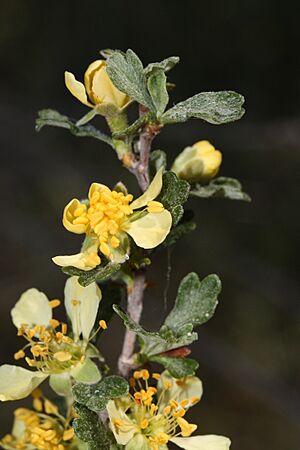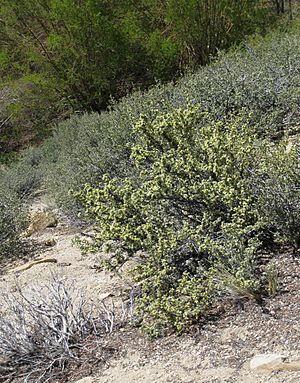Bitterbrush facts for kids
Quick facts for kids Bitterbrush |
|
|---|---|
 |
|
| Purshia tridentata, Wenas Wildlife Area | |
| Scientific classification | |
| Genus: |
Purshia
|
| Species: |
tridentata
|
| Synonyms | |
|
|
Purshia tridentata, often called bitterbrush, is a type of shrub found in the Rosaceae family, which also includes roses. It grows naturally in the mountains of western North America.
People call this plant by many names, like antelope bitterbrush, antelope bush, buckbrush, and quinine brush. Sometimes it's also called deerbrush, blackbrush, or greasewood. Some of these names are used for other plants too.
Contents
Where Bitterbrush Grows
You can find bitterbrush in many places across western North America. It grows from southeastern British Columbia in Canada, east to Montana and Wyoming, south into New Mexico, and west to California. It likes to grow on dry mountainsides and slopes.
In California, it's found at high places, from about 700 to 3,400 meters (2,300 to 11,150 feet) above sea level. This includes mountain ranges like the Peninsular Ranges, Transverse Ranges, and the Sierra Nevada. Farther north, in British Columbia, it grows at lower elevations, from about 320 to 1,065 meters (1,050 to 3,494 feet).
What Bitterbrush Looks Like
Bitterbrush is a deciduous shrub, which means it loses its leaves in the fall. It can grow to be about 1 to 5 meters (3 to 16 feet) tall. Its leaves are thin and usually have three to five small lobes, like tiny fingers. Each leaf is about 5 to 20 millimeters (0.2 to 0.8 inches) long.
This plant is special because it helps the soil. It's a nitrogen-fixing plant, which means it can take nitrogen from the air and put it into the soil. This makes the soil healthier for other plants.
The flowers of the bitterbrush are a pale yellow color. They have five petals, each about 6 to 8 millimeters (0.2 to 0.3 inches) long. The center of the flower has darker yellow parts called anthers. After the flowers, the plant produces small, dry fruits. These fruits are like tiny, leathery seeds, about 0.6 to 2 centimeters (0.2 to 0.8 inches) long.
Different Kinds of Bitterbrush
There are two main types, or varieties, of bitterbrush:
- Purshia tridentata var. glandulosa — This type is found in the eastern Sierra Nevada mountains and in Southern California.
- Purshia tridentata var. tridentata — This is the more common type found across most of its range.
Why Bitterbrush is Important
Bitterbrush is a very important food source for many wild animals, especially during the winter when other plants are scarce. Animals like deer, elk, and antelope eat its leaves and twigs. It helps them survive the cold months.



